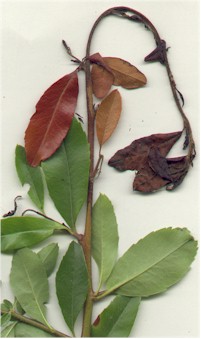 Common Name(s):
Common Name(s):Fireblight (Erwinia amylovora) |
 Common Name(s):
Common Name(s):
Scientific Name(s):
Erwinia amylovoraType:
BacteriaPrinciple Host Trees & Shrubs
: Rosaceae sub-family Pomoideae. Mainly Pyracantha (Firethorn), Sorbus (Whitebeam, Rowan), Crataegus (Hawthorn), Cotoneaster , Amelanchier, Chaenomeles (Quince), Mespilus (Medlar), Pyrus (Pear) and Malus (Apple).Does not attack Prunus (Cherry etc) or any plant not in Rosaceae sub-family Pomoideae.
Description, Development & Diagnosis:
The bacteria enters the stem through an injury or natural opening (such as its flowers) where it spreads and kills the cambium. The stem dies as it becomes girdled leaving a wilted, blackened shoot or branch tip. The bacteria overwinters within the bark and oozes from it in the following spring where it is then spread by insects, wind, rain, birds and pruning tools to complete the cycle.
Affected areas may look as if they have become scorched by fire. Shoot tips have a familiar shrivelled and hooked tip. A red or dark brown stain is visible on affected branch wood when the bark is scraped away.
Fruit remains attached but becomes blackened and shrivelled.
Significance:
This disease must be reported to MAFF if it occurs within premises registered for trade under the Plant Health Order 1993 i.e. plant nurseries.
Control:
Control by pruning out affected areas. Sterilise secateurs or pruners after each and every cut by wiping the cutting blades with methylated spirits. Burn all prunings - Do not compost.
Consider complete removal of badly affected trees or shrubs and replant with immune species.
| Further Information. |
© 2001 Chris Skellern. AIE. Home | News | A-Z Index | Resources | Contact AIE | Terms of Use